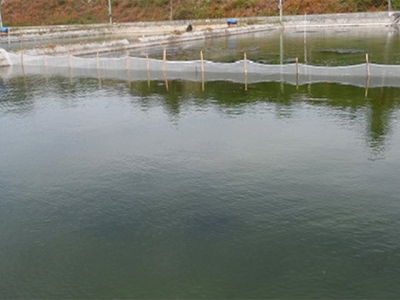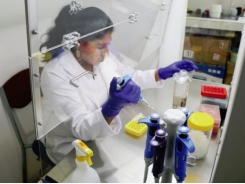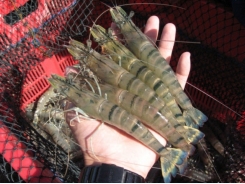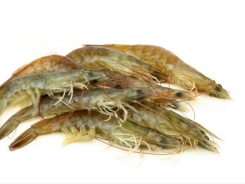Mixed feeding schedules benefit growth of Pacific shrimp

Study finds continuous feeding with a high-protein diet is not as practical
Cast netting of shrimps from the shrimp production pond of CFLRS-MSU for use in the study.
Aquafeeds are the most important cost in fed fish and shrimp aquaculture operations, especially considering that – even under appropriate feeding management – about 70 to 95 percent of the total feed is actually consumed by the cultured organism. In addition, the uneaten feed, nutrients that have leached prior the feed being ingested, feces and metabolic wastes all contribute to water quality deterioration, which ultimately affects overall fish or shrimp production.
The high cost of aquafeeds and their significant potential to create water quality issues – like elevated levels of ammonia and other toxic nitrogenous products; increased nitrogen and phosphorus concentrations that can result in dense phytoplankton growth and decreased dissolved oxygen and in extreme condition, oxygen depletion – are compelling reasons for the development of effective and efficient feeding strategies.
A mixed feeding schedule is a technique developed by De Silva (De Silva, S.S. 1985. Performance of Oreochromis niloticus (L) fry maintained on mixed feeding schedule of differing protein content. Aquaculture and Fisheries Management 16: 331-340) that involves feeding the fish with a high-protein diet alternatively with a low protein diet in a predetermined period of time.
The high-protein (HP) diet is a diet containing the optimum protein level while the low-protein (LP) diet is a diet with 10 percent lower protein content than what is required for optimum growth. This feeding strategy is based on De Silva’s observation on the daily variation on the apparent digestibility of dry matter and protein in the diets of the Asian or green chromide cichlid fish (Etroplus suratensis and Nile tilapia, or Oreochromis niloticus). This led her to conclude that continuous feeding of diets having high protein content is actually wasteful, as the fish cannot effectively utilize the feed at the same extent day to day.

Several researchers working on aquaculture nutrition have tested the efficiency of mixed feeding schedules to reduce feed costs in various cultured fish species like Nile tilapia, common carp, sutchi catfish and rainbow trout. All these studies proved the positive impact of mixed feeding schedules on growth of the finfish species tested. Some of these studies have also shown the effectiveness of this feeding strategy in controlling nitrogen and phosphorus inputs in the culture water, thus promoting good water quality in the rearing facility. Because mixed feeding schedules as a strategy in reducing feed cost has not been reported in the culture of Pacific whiteleg shrimp (Litopenaeus vannamei) we conducted the study presented here.
1/ Experimental design and setup
The feeding experiment was conducted for a total of 45 days in 15 circular, plastic tanks at the College of Fisheries Laboratory and Research Station, Mindanao State University (CFLRS-MSU), Bawing, General Santos City, Philippines. Prior to the experiment, 400 healthy shrimp postlarvae (PL30) were collected from the commercial pond of CFLRS-MSU and were distributed into 15 tanks for acclimation to laboratory condition for three weeks. Strong aeration was provided and the average water temperature during the feeding trial was 26 degrees-C.
Each tank was filled with 50 liters of brackish water (15 ppt salinity) and stocked in a complete randomized design with 20 healthy Pacific whiteleg shrimp juveniles (mean weight 1.3 ± 0.02 grams) with three replicates per treatment. This was a super-intensive stocking density equivalent to 450 shrimp juveniles per cubic meter.


Experimental tanks used in the study (l); note heavy aeration (r).
2/ Diet formulation and feeding management
Low-protein (LP) and high-protein (HP) diets containing 25 percent and 35 percent crude protein (CP), respectively, were formulated. Conventional feed ingredients used in the preparation of the diets – tuna meal, soybean meal, copra meal, rice bran, banana meal, cassava meal, corn flour, fish oil and vitamin-mineral mix – were sourced from Santeh Feedmill Corporation at Polomolok South Cotabato. Other ingredients with larger particle size – like soybean meal, copra meal and rice bran – were ground to make them into powder using an electric grinder (locally fabricated). Proximate analysis of the ingredients was performed Near Infrared Spectroscopy (NIRS).
The LP and HP diets were prepared by thoroughly mixing all the pre-weighed dry ingredients followed by mixing the oil and microingredients (vitamin-mineral mix). Water was added slowly until soft dough was produced. The mixture was steam-cooked and was extruded in a locally fabricated pelletizer. The pellets were dried to attain a moisture content of 10 percent with the use of a mechanical dryer at 60 degrees-C. The pellets were then reduced to the particle size suitable for the shrimp juveniles used in the study, and feeds were refrigerated at 0 degrees-C until used.
The treatment groups of Pacific whiteleg shrimp juveniles were fed continuously with low-protein diet (LP), continuously high-protein diet (HP), and according to the feeding schedules: 1 day low-protein diet and 1 day high-protein diet (1LP/1HP); 2 days low-protein diet and 1 day high-protein diet (2LP/1HP); and 3 days low-protein diet and 1 day high-protein diet (3LP/1 HP). Animals were fed five times a day, seven times a week at 6 percent of the body weight during the first 20 days, and 5 percent of the body weight thereafter.
3/ Water quality management
Seawater was obtained through direct pumping from the sea and freshwater from a deep well, and were mixed to produce the desired experimental salinity of 15 ppt. Before feeding in the morning, 20 percent of the water in each experimental tank was replaced with the same amount of fresh brackish water; and in the evening, about 30 percent of the water was exchanged and fecal wastes removed through siphoning. Physico-chemical parameters such as temperature, dissolved oxygen (DO), pH, ammonia-nitrogen, nitrite-nitrogen and nitrate-nitrogen were monitored regularly before feeding in the morning and two hours after feeding in the evening.
4/ Growth monitoring, statistical and feed cost analysis
Shrimp growth was monitored by weighing the entire shrimp population in bulk every 10 days using a digital scale. Growth in terms of weight gain, percent weight gain, specific growth rate and survival rate as well as feed utilization parameters – such as protein efficiency ratio (PER) and feed conversion ratio (FCR) – were computed and the results were subjected to one-way analysis of variance (ANOVA) using commercial statistics software.
Computation of the cost per kilogram of the diets considered the actual cost of the ingredients plus 10 percent processing cost. Feed cost per unit mean weight gain was calculated by determining the cost of feed per shrimp divided by the mean weight gain of shrimps. Average protein consumption, the cost of protein consumed per shrimp and the cost of protein per body weight gain were computed to determine which of the diets and combinations was the most cost-effective.
5/ Results
The lowest and highest ammonia-nitrogen and nitrite-nitrogen levels were observed in low-protein (0.1 to 1.0-3.0 mg/L) and high-protein (0.1-0.25 to 0.1-2.0) diets, respectively.
Other parameters such as temperature and pH were within the optimum range as well as the dissolved oxygen (DO), except two hours after feeding in the evening when DO levels dropped below optimum.
Mandas, mixed feeding schedules, Table 1
| Treatments | Initial weight (g) | Final weight (g) | Weight gain (%) | Specific growth rate (%/day) |
| Low-protein (LP) | 1.28±0.05 | 5.4±0.62 | 323±61 | 2.56±0.55 |
| High-protein (HP) | 1.32±0.02 | 5.5±0.31 | 317±16 | 2.20±0.31 |
| 1 LP / 1 HP | 1.32±0.02 | 4.7±0.21 | 260±15 | 1.57±0.51 |
| 2 LP / 1 HP | 1.33±0.02 | 5.6±0.30 | 318±19 | 2.10±0.11 |
| 3 LP / 1 LP | 1.28±0.02 | 4.8±0.52 | 274±44 | 1.92±0.35 |
Table 1. Growth performance of Pacific whiteleg shrimp juveniles fed LP and HP diets and at various mixed feeding schedules.
Initial and final weights, percent weight gain and specific growth rate of Pacific whiteleg shrimp juveniles are presented in Table 1. The numerically highest growth in terms of weight gain was attained in shrimp fed 2 days continuously with a low protein diet alternately with 1 day high-protein diet (2LP/1HP; Fig. 1). The shrimp in this treatment had a weight increment of 318 percent, slightly higher than the shrimp fed continuously with high protein diet (317 percent). Specific growth rate (2.6 percent) and survival rate (77 percent) were highest while feed conversion ratio was lowest in shrimp maintained with continuously low protein diet (LP).

Fig. 1: Weight gain of Pacific whiteleg shrimp juveniles fed LP, HP diets at various feeding schedules.
Differences in weight gain, specific growth rate, survival rate (Fig. 2) and feed conversion ratio (Fig. 3), however, were not significant between treatments (P>0.05). Significantly highest PER (Fig. 4) was seen in the continuously low protein (LP) treatment (P<0.05); and in terms of cost of protein per gram shrimp gain, this treatment was also the cheapest one (P0.05/g) and the high-protein treatment (HP) was the most expensive one (P0.09/g). The various mixed feeding schedules (1LP/1HP, 2LP/1HP and 3LP/1HP) showed uniform cost of protein per gram increase in shrimp body weight (P 0.07/g), which appeared slightly expensive than the LP diet but cheaper than the HP diet (Table 2).

Fig. 2: Survival rate of Pacific whiteleg shrimp juveniles after 45 days of the feeding trial.

Fig. 3: Feed conversion ratio of the low protein and high protein diets and various mixed feeding schedules.

Fig. 4: Protein efficiency ratio of the LP and HP diets and various mixed feeding schedules.
Mandas, mixed feeding schedules, Table 2
| Treatments | Total feed consumed (g) | Total protein intake (g) | Average protein consumption per shrimp (g) | Cost of protein consumed per shrimp (P/pc) | Cost of protein per body weight gain (P/g) |
| Low-protein (LP) | 132.7 | 33.18 | 2.15 | 0.19 | 0.05 |
| High-protein (HP) | 135.8 | 47.54 | 3.66 | 0.37 | 0.09 |
| 1 LP / 1 HP | 105.7 | 29.6 | 2.55 | 0.24 | 0.07 |
| 2 LP / 1 HP | 130.96 | 37.1 | 2.99 | 0.29 | 0.07 |
| 3 LP / 1 LP | 116.59 | 33.0 | 2.54 | 0.24 | 0.07 |
Table 2. Feed and protein consumption and cost.
6/ Perspectives
Results of this study showed comparable growth and survival performance of Pacific whiteleg shrimp juveniles fed with either high- or low-protein diets or fed under various mixed feeding schedules. The highest average protein consumption per shrimp (3.66 grams) was observed in the HP diet, but this did not result in superior growth of the shrimp over other treatments where protein consumption was lower. This indicates that the protein in LP diets and in various mixed feeding schedules were efficiently utilized to result in good shrimp growth despite the lower protein intake in these treatments.
The LP diet significantly prevented total ammonia nitrogen input in the water, which helped maintain good water quality and in turn might have influenced efficient utilization of the protein by the shrimp, and therefore impacted growth positively.
In our experiment – where shrimp were cultured at extremely high density in a closed system – we determined that continuous feeding with high-protein diet is not practical, as shown by the highest cost of protein incurred per gram increase in shrimp weight (P0.09). Also, it was wasteful to continuously feed the HP diet because this did not result in rapid weight gain, and instead it greatly contributed to increased total ammonia levels, which has negative effects on both shrimp growth and survival. Under the conditions of our experiment, feeding the shrimp with the LP diet and under mixed feeding schedules was more practical than feeding the shrimp continuously with the HP diet.
References and additional information on this study available from corresponding author
Có thể bạn quan tâm
Phần mềm

Phối trộn thức ăn chăn nuôi

Pha dung dịch thủy canh

Định mức cho tôm ăn

Phối trộn phân bón NPK

Xác định tỷ lệ tôm sống

Chuyển đổi đơn vị phân bón

Xác định công suất sục khí

Chuyển đổi đơn vị tôm

Tính diện tích nhà kính

Tính thể tích ao hồ




 Brazilian shrimp farmers eye new horizons
Brazilian shrimp farmers eye new horizons  Shrimp trial sets stage for insect protein in…
Shrimp trial sets stage for insect protein in…